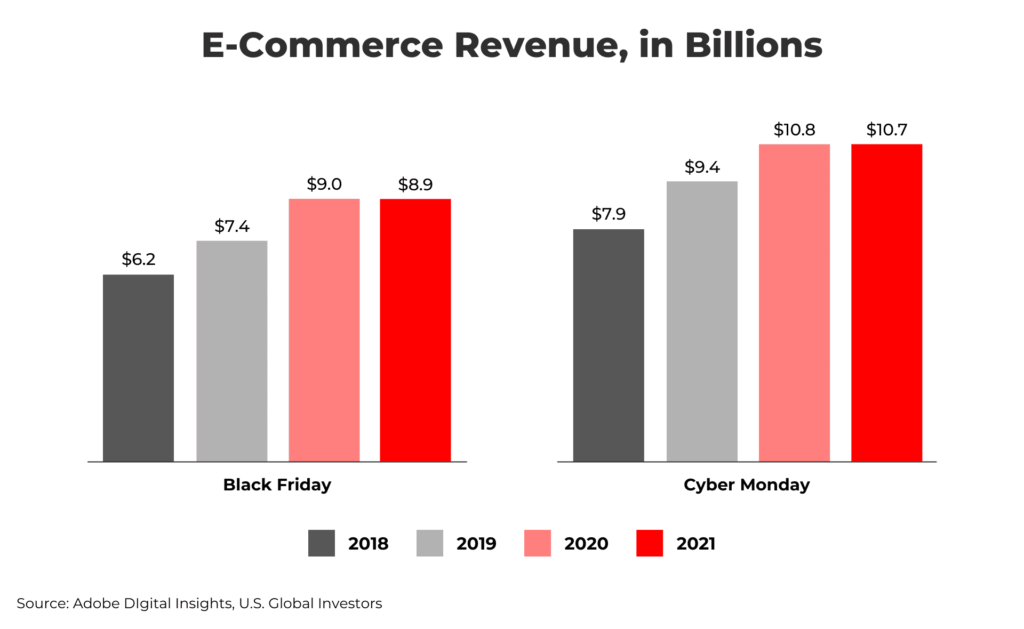
Cyber Week, which ended with Cyber Monday, was the biggest online shopping day of the year, even if the sales were slightly less than those compared to the previous year (ref to Fig 1). That’s what the data from Adobe Analytics says, which is based on one trillion visits to U.S. retail sites, 100 million SKUs, and 18 product categories. Close to 180 million Americans shopped during the Cyber Weekend (defined as Thanksgiving through Cyber Monday).

Cyber Monday sales were at $10.7 Billion, about 1.4% down compared to last year, while the Thanksgiving Day sales were the same compared to the previous year. Cyber Week drew a total online spend of $33.9 Billion.
Not all retailers saw a decline in online sales compared to last year. For instance, Amazon mentioned officially through their blog that it was a ‘record-breaking Black Friday and Cyber Monday’ for the company without going into the specifics. Home goods, toys, and apparel are the top-selling categories. Data from various sources reveals that while sales volume saw growth over the holidays, it didn’t happen as much compared to the last year.
While this news may look worrisome on the surface, it isn’t if you scratch deeper. Here’s some exciting news. Salesforce, through its research, found that US sales for the first three weeks of November are up 10% YoY, which shows that consumers started shifting their spending to earlier in the season, having become aware of the supply chain issues and shipping delays. So record online sale is very much on track if you look at the bigger picture, and the demand is spread out across a more significant time window instead of just peaking around typical holiday shopping days.
This is what Taylor Schreiner, director of Adobe Digital Insights, said in a statement. “Consumers have been shopping strategically this season: Buying early and taking advantage of deals retailers have been promoting since late October. Black Friday still remains a major online shopping day, but the surge in online shopping is coming from the less marketed days of the season.”
Ten Key Takeaways
With this background, let’s look at the key trends and shopping insights from Cyber Week 2021.
- If Anything, Consumption Has Grown – The number one reason why this year’s Cyber Week didn’t set any new records is that shoppers are spreading their buys across months and not waiting for deal days. As per Adobe, for November 2021, American consumers spent $109.8 billion online, a 12% increase over November 2020, with 22 days of the month exceeding $3 billion in shopping, a new milestone. Even at a global level, consumption has been solid. Shopify witnessed $2.9 Billion sales worldwide on the eve of Black Friday, a massive increase of 21% YoY.
- Amazon Kicked Off the Holiday Season Early – Amazon started the holiday deals early from Oct 4th. Customers could save big over the Black Friday and Cyber Monday holiday shopping weekend. As per Amazon, they were able to offer incredible savings compared to other retailers. As per the industry analyst firm Profitero, Amazon had a whopping 14% lower prices than other major retailers across all major categories going into the holiday season. Some of the best-selling items from Amazon include Oculus Quest 2, Advanced All-in-One Virtual Reality Headset, Beats Solo3 Wireless On-Ear Headphones, Bose QuietComfort Noise Cancelling Earbuds, Fire TV Stick with Alexa Voice Remote, Echo Show 10 (3rd Gen), and Mario Party Superstars – Nintendo Switch.
- Brands/ Retailer Started Promoting Early – Taking a cue from Amazon, brands/retailers set up their discounts earlier than usual. The underlying strategy was to capture the early shoppers and address consumers’ anxiety who worried that items might run out. As a result, there was higher advertising and paid spend in the days leading up to the cyber week. The winners during this period were brands that promoted their deals more effectively. For instance, Amazon carried a “Cyber Monday Deal” tag on some of its items.
- Carts Became Bigger – The shopping cart price point saw a jump of 13.9 percent on Cyber Monday and an overall uptick of 19% percent for the holiday season. There are two ways to draw inferences from this data. In all likelihood, consumers are buying more bigger ticket items online, and also, the online prices have gone up in the last few months owing to an increase in shipping charges and supply chain issues.
- Consumer Faced Higher Prices and Lesser Discounts – Overall, higher inflation and lesser discounts meant that consumers struggled to find great deals. During the cyber week period, the average selling price was up by 11 percent, and the average discount was down by 6 percent compared to last year. As per Abode Analytics, discount levels for electronics were at –12 percent (vs –27 percent last year), TVs at –13 percent (vs –18 percent last year), apparel at –18 percent (vs –20 percent last year), sporting goods at –8 percent (vs –20 percent last year), appliances at –8 percent (vs –20 percent last year).
- Holiday Inflation Gave Tailwind to BNPL – The Cyber week saw an uptick in BNPL (Buy Now Pay Later) usage with a 21% uptick in revenue. With higher prices and lesser discounts, it was a given that many consumers would make use of the BNPL feature. As per Adobe, this type of surge in BNPL usage is likely to happen again around Christmas.
- Out of Stock Items Affected Holiday Buzz – The pandemic shadow continued to loom over the holiday season; the prevalence of Out of Stock messages went up by a whopping 169 percent as compared to pre-pandemic levels; some of this is likely to continue through December as per the estimates from Adobe.
- Curbside Pickup Picked Up – On the heels of recovering from the pandemic, customers across the US continued to health and safety. As a result, stores offering curbside pickup saw a growth of 50 percent in revenues compared to stores that did not provide this facility. The lasting demand for curbside pickup is a significant value creator for physical stores.
- Big Boost to Big Box – Big Box retailers with annual revenue of $1 Billion and above saw higher average revenue growth of over 22 percent since the beginning of October. Smaller retailers couldn’t witness that kind of growth during the same period. The significant advantage the bigger retailers had was that their broader assortment of products could hold the shopper on their sites and apps longer.
- Mobile Shopping Took a Hit – Across the cyber week season, mobile shopping accounted for close to 40 percent of online sales as compared to the desktop. This is an 8.4 percent growth YoY. The pandemic has put more people inside their homes; as a result, mobile as a channel for shopping has lost some of its sheens. On the other hand, consumers are still actively using this channel to browse and research products.
Final Thoughts
So, while the growth might have slowed down a bit for the cyber week, consumption hasn’t gone down. Cyber 5 isn’t a 5-day shopping event anymore; both consumers and suppliers are training themselves to start early. Amazon has taken to lead to start things earlier. Consumers were also entering the holiday season aware of the supply chain issues and higher prices, driven by inflation. Hence, they were offsetting some of these by spreading their shopping over longer.
Related Articles
Turn Insight Into Impact.
Start Today.




